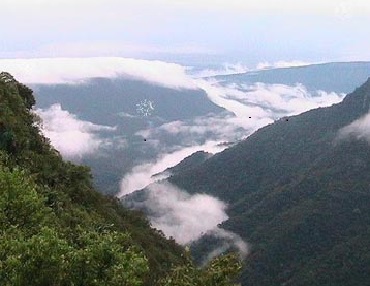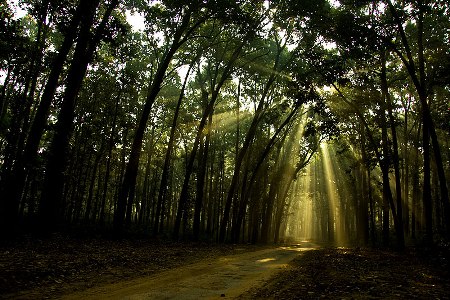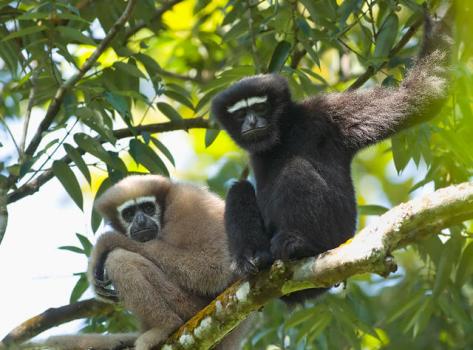PHYTOGEOGRAPHICALLY
Phytogeographically many taxa, viz., Elaeocarpus sp., Munronia pinnata, Hovenia dulcis Scheichera trijuga, Dillenia pentagyna, Neillia thysiflora, Helicia sp., and Nepenthes khasiana etc. are of great significance, showing best examples of discontinuous and trans-specific distribution.
The vegetation of the Garo Hills can be broadly classified into the flora of tropical and sub-tropical zones based on altitude.
The Flora of Tropical Zone

The tropical vegetation covers areas upto an elevation of about 1,000 m. The majority of the forests. Viz. Dilma, Dhima, Chimabangsi, Rajasimla Eldek, Darugre, Songsak, Siju, Rewak,Emangre, Baghmara, Phulbari, Rongmachokgre, Rongchugre, singgimari, etc. fall in this zone . It embraces evergreen, semi-evergreen and deciduous forests, bamboo thickets and grasslands including riparian forests and swamps. These forests mainly consist of Shorea robusta and in certain area tectona grandis has also been introduced. The tallest trees are Schima wallichii, Terminalia belirilia belirica, Engelhasdtia spicata, Aesculus assamica, Aporusa wallichii, Bridelia retusa, Cryptocarya andersonii, Talauma hodgsinii, Lagerstroemia parviflora, Gmelina arborea, Munronia pinnata, Toona ciliate, Dillenia pentagyna, Dillenia indica, gymnosporia saltficifolia, Leea macrophylla, Growia ap., Ficus spp., syzygium kurzii, Catanopis armata, Terminalia chebula, Vetex pedunchrularis, Hovenia acerba, Butea monosperma, Pilioatigma malabaricum, Schleichera trijuga, etc.
Miliusa velutina, Hibiscus macrocarpus, Zizyphus rugosa, Helicia robusta, Engelhardtia spicata var. Colebkookiana and Ficus Prostrata, etc. form the lower canopy. The main components of shrubby species are-Capparis zeylanica, Garcinia lancifolis, Bauhinia acuminate, Mimosa himalayayana, Acacia concinna, Mussaenda roxburghii, Eupatorium nodiflorum, Solanum kurzii and Phlogacanthus tiboflorus, etc. In a few areas, numerous lianas intertwining the trees, e.g., Dysolobium grande, Mucuna bracteata, Fissistigma wallichii, Paederia scandens, solena hetephylla and Aristolocjis saccata ae prominent. Rarely, Aristolochia cathcartii may be seen in certain forests. Several species of bamboo stretch for long distances formaing thickets of secondary vegetation without any competition. A few falms like Areca, Caryota, Pinanga and Didymosperma are also conspicuous. The ground flora in deciduous forests is very poor and seasonal, while in evergreen forests, species of epiphytic climbers viz, Rhaphidophora spp., members of Gesneriacease, Hoya app. With beautiful bunches of star like flowers and stem parasites of Loranthacease viz. Dendrophthoe falcata, Helioxanthera ligustrina, Lorathus scurrula, Macrosolen cochinchinencis and Total root parasite Cascuta reflexa are also seen. A few species of epiphytic orchids viz. Aeridis, Bulbophyllum, Dendrobium, Eria, Liparis, Pholidota, Thunia and Vanda etc. are seen in the evergreen Forests but they show less species diversity. The herbaceous vegetation is less profuse and includes the members of Oxalidaceae, Balsaminanceae, Acanthaceae, Leesceae, Fabaceae, Asteraceae and Poaceae. Besides, Sida spp., Leea spp., Coffee benghalensis, Imperata cylindrical and Chromolaena odorata, etc. are also predominant. Ferns and fern-allies, liverworts and mosses, etc. are also seen on old tree trunks and stones etc. near sources, in shady place in the evergreen forests but species diversity is very poor. Due to excessive Jhum practice most of the forest areas are cleared and secondary monoculture forests of Shorea robusta established, Tectona grandis, Lagerstroemia parviflora are seen in most places. Artocarpus spp. Are also vary common in the vicinity and towns. In more or less open moistlocalities and near water sources, herbs like Dictyospermum, Aneilema scaberrimum, Burmania sp., Ciox spp. Cyprus spp. Oxalis corniculate, Anemone spp. And Ericcaulon etc. can be seen. A botanic curio shrub Nepenthes khasiana grows in and around Baghmara.
The Flora of Sub-Tropical Vegetation

The sub-tropical vegetation occurs at elevtion above 1200 m from sea level and this type of forest is restricted to Tura peak, Nokrek peak etc. These are mainly evergreen forests but a few elements of deciduous forests are also seen. The top canopy is contributed by Castanopsis hystrix, Betula culindristachvs, Kavea floribunda, Garoinia affinis, Cyathocalvx martabanicus, Talauma rabaniania, Taluma phellocarna, Dryntes phellocarna, Dryntes lancifolis Pasania xylocarpa, Fiscus spp. And vitax altissima aldina cordufolia, Sterculia villosa, Garuga pinnata, Machilus gamblei, M.villosa, Milletia orainii, Carnicia paniculata, Sageraea Juarina, sysmolocus ferruginea, Eriobotrya benghalensis, Emblica offinialis, Ebretia aciminata, Quercus semiserrata, Betula alnoides with Litsea spp. etc forming the middle canopy of trees. The lowest canopy comprises Aglata roxburghii, Antidesma bunius, Breynis patens, Pasania spicata, Mitrephora tomentosa, syyrax serrulatim, Premna multiflora. Litsea spp. and Ficus spp. etc. and is followed bu shrubs and bushes of 1 m to 3 m in height like Munronia pinnata, Flemingia latifolia, Eriobotya angustissima, Blumea balsamifera, Antistrophe oxyantha, Rauwolfia serpentine, Strobilanthes glomeratus and Erianthus spp. etc.
Entada phaseoloides, Conophalus suaveolens, Dalbergia stipulacea, Spatholobus roxburghii and vitis latifolia, etc. stretch from one tree to another in the forests. The high altitude coupled with low temperature and moisture is congenial for the prolific growth of epiphytic flora. The branches of old tree trunks are moss-laden and are fully covered by epiphytic orchids, though species diversity is very low. Ferns, liverworts and mosses etc. are also predominant in this region. Among other plants of heterotrophic mode of nutrition are Balanophora dioica, Momotropa uniflora, Drosera spp. and Urticularia spp. and several species of Polyporales and Agaricales etc.
It may be observed that only about 5% of the forest area of Garo Hills is under Government. The rest is under the jurisdiction of the District Council. Forest pockets are however, only confined to the banks of revers and rivulets except in the Tura peak and the Nokrek peak forests and the Balpakram Wild-life Sanctuary etc. Due to excessive jhuming, road and building constructions and urban expansion etc. many taxa viz. Aristolochia cathcartii, Cyathocalyx martabanicus, Sageraea laurina, Talauma rabaniana etc. of this region are being depleted and this has result not only in an irreplaceable loss of the green heritage but will also jeopardize ecological stability. These forests are a unique source of medicinal plants, and disease and pest-resistant strains of plants have been developed by the selection of new genes from the forests. This tropical gene pool contains edible plants, fruits and plants of great economic value. Man with all his ability to create, can never replicate what we find in these forests. Although, or perhaps because, these forests are not man's work, it is very much man's responsibility to conserve them for posterity.
Fauna of Garo Hills

The Garo Hills area of Meghalaya is famous for numerous hill tracks as well as
good number of streams and rivers. Both terrestrial and aquatic fauna are found to be rich in this region.
The large number of mammalian fauna includes the Hoolock Gibbon (Hylobates hoolok), the Stump-tailed Macaque (Macaca speciosa), the Rhesus Macaque (Macaca mulatto),
the Assamese Macaque (Macaca Assamesis), the Slow Loris (Nycticebus cuocang), the Golden Langur (Presbytis geet), the Capped Monkey (Presbytis pileatus),
the Common Langur (P.entellus), the Tiger (Panthera tigris), the Leopard (Panthera pardus), the Clouded Leopard (Neofelis nebulosa), the Golden Cat
(Felis temmincki), the Leapord Cat (Felis bengalensis), the Marbled Cat (Delis marmorata), the Jungle Cat (Felis chaus), the Large Indian Civet (Viverra zibetha),
the Masked Palm Civet (Paguma larvata), the Binturong (Arctictis binturong), the indian Grey Mongoose (Herpestes edwardsi), the Indian Fox (Vulpes bengalensis),
the Asiatic Black Bear (Selenartos thibetenus), the Yellow Throated Marten (Martes flavigula), the Yellow-bellied Weasel (Muastela kathiah),
the Madras Tree Shrew (Anathena elloiti), the Indian Flyingfox (Pterropus giganteus), the Malayan Giant Squirrel (Ratufa bicolor), the Irrawaddi Squirrel
(Callosciurus pygerythrus), the Particoloured Flying Squirrel (Hylopetes alboniger), the Bandicoot Rat (Bandicota indica), the Lesser Bamboo Rat
(Cannonmys badius badius), the Black Naped Hare (Lepus nigricollis), the rufous-tailed Hare (N.L.ruficaudatus), the Indian Crested Porcupine (Hystirx Indica),
the Guar (Bos gaurus), the Sambar (Cerbus unicolour), the Cheetal (Axis axis), the Muntjac of Banking Deer (Muntiacus muntjak), the Indian Wild-bour (Sus scrofa)
and the Wild Dog (Cuon alpinus). In addition, different species of Bats (Cynopterus sphinx gangeticus, Rhinolophus subbadias, Hipposideros lankadiva) have also
been recorded from the region.
Different varieties of beautiful birds are in abundance in the forest areas of the region. These are the Indian Black Baza (Aviceda leuphotes), the Barred Jungle owlet (Glaucidium radiatum), the Red Jungle-fowl (Gallus gallus), the thick-billed Green Pesion (Treron curvirostra), the Blu Throated Barbet (Megalaima asiatica), the Long-tailed Broadbill (Psarisomus dalhousiae), the Grey-helded Myna (Sturnus malabaricus), the Jungle Myna (Arridotheres fuscus), the Green Magpie (Cissa chinensis), the Indian House Crow (Corvus splendens), the Red Winged Crested Cuckoo (Clamator coromandus), the Large Gree-billed Malkoha (Rhopodytes tristis), the Crow Pheasand (Centropus sinensis), the Red-Headed Burmese Roller (Coracias benghalensis), the Broad-billed Roller (Eurystomus orientalis), the Redwattled Lapwing (Vanellus indicus indicus), and the Spur-winged Plover (Vanellus spinosus duvaucetti). Some other varities of birts like the White-creasted Laughing Thrush, the Scarlet Minivet, the Black-headed Oriole, the Cuckoo-shrike, the Green Barbet, the Chloropsis, the Himalayan Barbet, the White-capped Redstart, the Magpie Robin, the Yellow Bulbul, the Brown Fish Owl, Bee-eaters, the Serpect Eagle, the Hills myna, the Pied Myna, the Grey-headed Sibia, the Slaty-headed Scimitar Babbler as well as various species of Hornbills, Nightjars, Egrets, Parrots, Swallow-Shrikes have also been reported.
Reptile fauna include different varieties of lizards, snakes, turtle/tortoises. Different species of lizards, geckos and skinks include Calotes emma, C.versicolor, enemaspis jerdoni, Cyrtodac tylus khasiensis, Cosymbotus platyurus, Hemidaxtylus brooki, H.frenatus, Gekko, Japalura planidorsata, Sphenomorshus indicum, S.maculautm, Mabuya macularia, M. multifasciata, Varanus bengdalensis and V. salvator. Differenct species of snakes include Blind snakes (Typhlops diardi, T.tenuicollis, Ramphotyphlops braminus), Indian Gamma (Biogatrigonata), Chechered Kellback (Xenochrophis piscator), Red necked Keelback (Rhabdophis subminiata) and others (Amphiesma khasiensis, A.parallela, A.xenura, Calamaria pavimentata, Chrysopelea ornate, Elaphe hodgsoni, E. prasina, Lycodon aulicus, L. jara, Oligodon cinereus, O. cyclurus, O. dorsalis, O. theobaldi, Ptyas korros, sibynoohischinensis, Bungarus bungaroides, B. faciatus, B. niger, Callophis macclellandi. Imporatant poisonous species include Indian Cobra (Naja naja) and vipers (Trimeresurus) erythrurus). With a good number of streams and rivers, the region is rich fauna also. Commercially important groups include major carps (Labeorohita, L. conius, L. calbasu, Neolissocheilus hexagonolepis, N. hexastichus, Cirrhinus mrigala), minor carps (Barilius bendalisis, B. barna, B. tileo, Puntius sarana, P. sophore, P. ticto, P. conchonius, P. clavatus, Garra lamta, G. nasuta, G. gotyla, G. naganensis, slmontoma bacaila, S. phulo, Osteobrama cotio, Parluciosoma daniconius, Bengala elanga, Raiamas bola, Cirfhinus reba). Other carps are Tort tor, T. putitora, Cyprinus, carpio, Labeopangusia, L. boga, L. dero. Other economically important groups are Bagrids (Mystus bleekeri, M. vittatua, Aorichthys seenghala), Silirids (Ompok bimaculatus, O. pabo, Wallago attu), Cat fishes (Clarias battrachus, Heteeropneustes fossilis), Murrels (Channa punctata, C. Striatus, C. Marulius), Percoids (Anabas tesudineus, Nandus nandus, Colis fasciatus), Eels (Mastacembelus armatus, Macrognathus pancalus, M. aral), Featherbacks (Notopterus ghitala, N. Notopterus) and Clupeids (Gudusia chapra).
